Long ago in an earlier life, Barry Brickell was a teacher in Auckland. In 1961, at age 26, he gave it all up and moved to Coromandel. Barry Brickell was not a teacher, he was an artist, a potter, and he wanted somewhere to live out that truth. In 1973 he bought a small remote property hidden away out of town. He established a pottery workshop, and eventually started a pottery co-op. The land he chose had rich resources of clay for his pots, and self-seeded pine trees that had been introduced during the gold rush of 1852 that would be perfect fuel for his kilns.
The clay and the pine trees were way up a hill. The whole property was hilly, practically mountainous, and Barry needed a way to get that heavy clay and pinewood down the mountain to his workshop. The solution was inevitable really. Barry was a railway enthusiast, and something of an engineer, so he built himself a railway. By hand.
He began small, laying only six hundred metres of narrow gauge track, cutting his way through rough bush and steep inclines, using home made surveying equipment, and excavating using barrows and shovels. The rails were second-hand, some a little corroded.
And then he built himself a ‘train’ to run on those rails. Old wheels and axles came from a brickworks in Wellington. The train looked something like an old tractor with a couple of flatbeds attached. You can see it during the first couple of minutes of this seven minute video. The rest of the video is of Barry working in his pottery workshop. He didn’t make teacups. His pots are hand-turned and huge.
His love of trains, since childhood, led him to decide he “must build the most beautiful mountain narrow gauge railway in the world.” When he wasn’t building kilns, and making pots, terracotta artifacts and sculptures, Barry Brickell poured much of his money, time and energy into developing the railway. He called it Driving Creek Railway after the creek in the area. The name Driving Creek comes from the Kauri timber milling days when logs were transported down the creek to the sea after being released from driving dams in the hills.
He had bulldozers in for digging deep cuttings. Some places required civil engineering works due to the steep and difficult terrain. He created an engineering workshop and built passenger trains right there on the property. In 1975 he bought more land. At one point his bank manager told him that he had to start taking paying passengers to bring down the huge overdraft he had amassed to build his “toy train”. He made $1500 that first year in 1990. And used it to buy more track.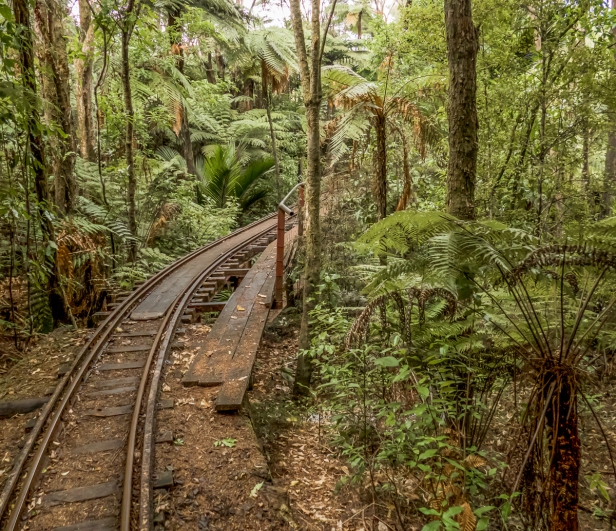
Driving Creek Railway slowly expanded and is now three kilometres long. Its construction took Barry about thirty years. The track has horseshoe spirals and switchbacks, and changes direction five times as it zigzags up the hill. There are ten bridges, three tunnels,
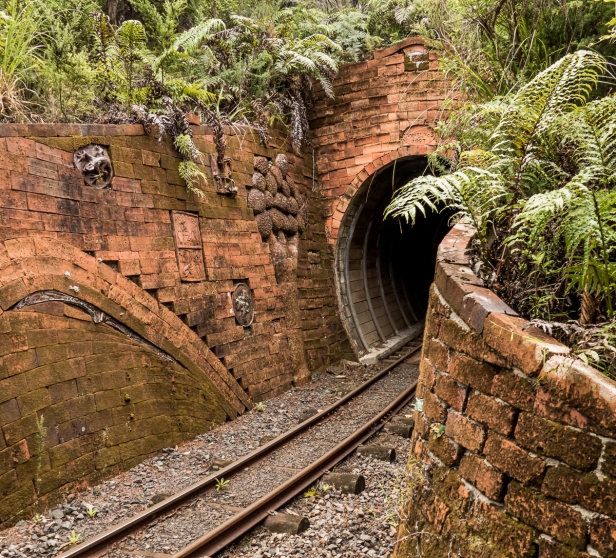
and a double-deck viaduct.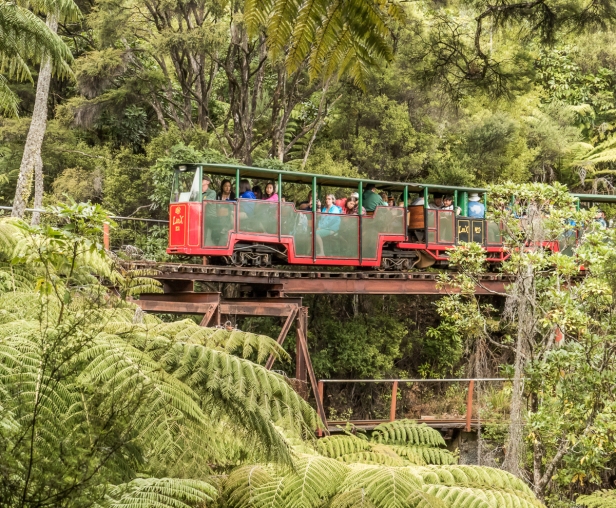
Three open-sided diesel-powered carriages for passengers were custom-built in the engineering workshop.
The line terminates at the Eyefull Tower, a hexagonal building and viewing platform 165 metres above sea level with panoramic views of Hauraki Gulf.
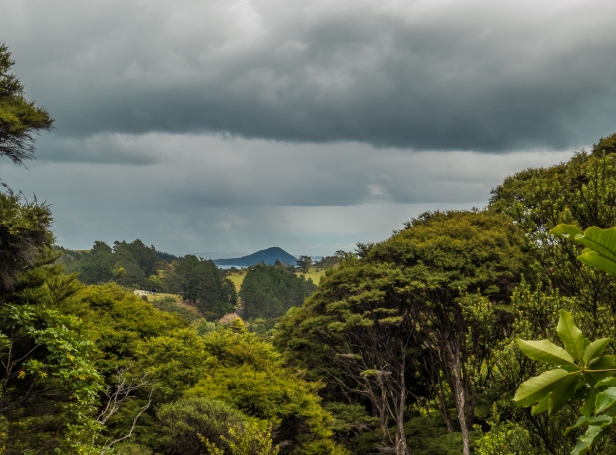
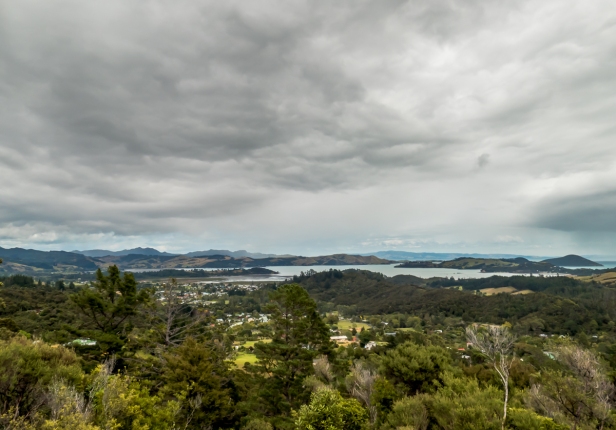
After buying our tickets at the ticket office and looking around the store,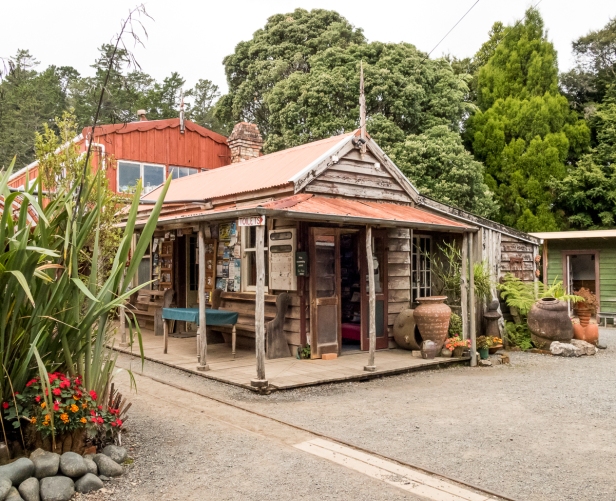

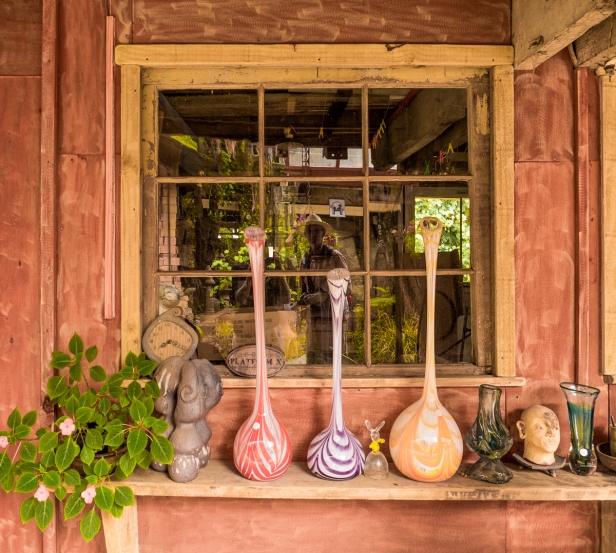
we boarded the train.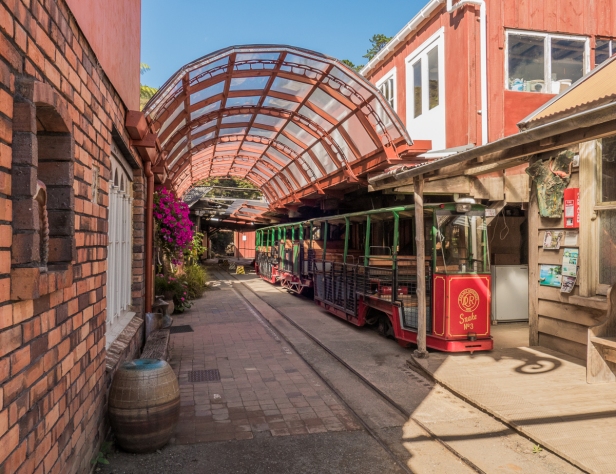
“Keep your arms and heads inside the train, the tunnels are very narrow” our driver shouted,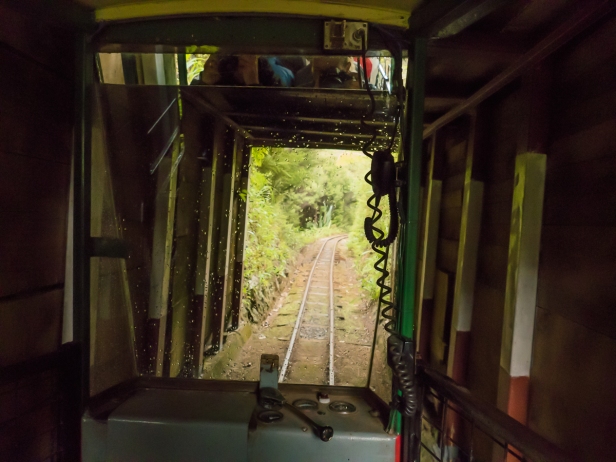
and up the mountainside we went. At times the driver stopped to switch the points. At times, after coming to a dead stop, he walked to the other end of the train to take it up the zigzag in the opposite direction. It was clear he loved his job.
At every turn there was art – small terracotta figurines in the forest beside the track, retaining walls with pottery relief sculptures, retaining walls built from bottles, and fence posts with terracotta pinacles.

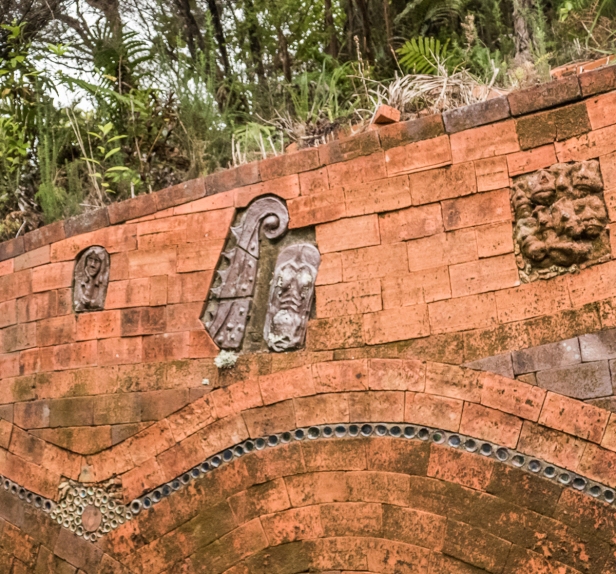
The tunnels weren’t the only reason to keep arms and head inside. At some places the forest closes right in on the train. Apart from pottery, and building railways, Barry’s other passion was returning the forest to its natural state. Over the years as Barry and his cohorts brought pinewood down the mountain they carried up and planted twenty thousand native trees, including nine thousand kauri trees.
At the top, apart from the beautiful view, there was finally a chance to get a photograph of the ubiquitous New Zealand Fantail,
and back down at the bottom, two more of New Zealand’s native birds, a wattled Tui,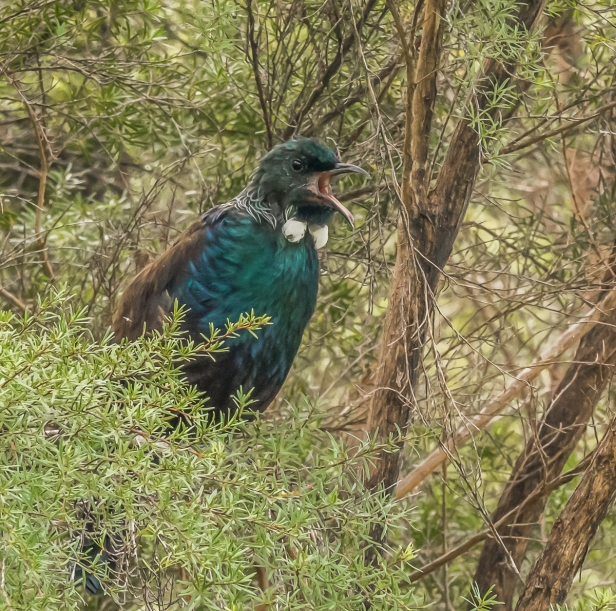
and a Keruru, or New Zealand Wood Pigeon.

It’s possible that if he knew what he was getting himself into he would not have started, but from what I gleaned about Barry Brickell he would have gone ahead anyway. His huge gamble has paid off. Thirty thousand people ride the Driving Creek Railway every year, and you need to book in advance. A large proportion of the proceeds go to fund conservation works. You can see a little more about him and his railway in this video starting at about 10.56.
Next post: Sacred Long Dance of the soul.
All words and images by Alison Louise Armstrong unless otherwise noted
© Alison Louise Armstrong and Adventures in Wonderland – a pilgrimage of the heart, 2010-2015.
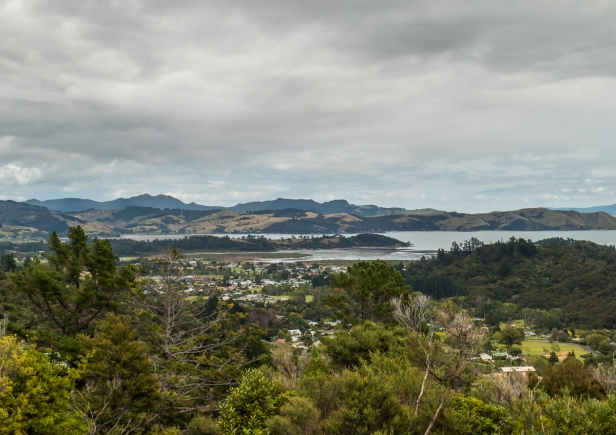

Great story and wonderful photos, especially the birds!
LikeLiked by 1 person
Thanks Caroline. We thoroughly enjoyed it. And the birds – what luck! I’d been seeing the tuis and fantails all over NZ but couldn’t get a decent shot. And the keruru was a beautiful bonus.
Alison
LikeLike
Wow! And wow again. Fabulous story and amazing photos. Thank you!
LikeLiked by 1 person
Thanks so much Donna. He’s an amazing man. He’ll be 80 this year. I think he’s finally slowed down a little!
Alison
LikeLike
What an inspiring place. If that is what amounts to following your inner voice, let me continue to strive inward.
LikeLiked by 1 person
No kidding! I think he lived his entire life just following his inner voice. So inspiring. Initially I think his pottery (and his overdraft!) paid for the railway. Now the railway pays for the pottery, and all his conservation projects.
Alison
LikeLiked by 1 person
What a beautiful railway! Such a pretty trail too Alison. 😃
LikeLiked by 1 person
Isn’t it lovely?! And yes, through beautiful countryside. We loved it.
Alison
LikeLiked by 1 person
What an incredible story and a remarkable man.
LikeLiked by 1 person
Yes, I agree. Like I said, I think he’s a force of nature. There are not so many people who have such a clear vision of how they want to live their life. And those that do, it seems, are the ones we look up to because they live their truth.
Alison
LikeLike
Awesome stuff Alison. We will have to look that place up when next we visit the North Island.
LikeLiked by 1 person
Thanks Geoff. Do go there next time you’re in NZ. We loved it.
Alison
LikeLike
What an adventure your life has become. I love that you share all these amazing, interesting stories and photos.
That is a very narrow railway! Love how it’s just incorporated into the natural surroundings.
A dentist where we live is into trains. My husband has been helping him design a short train to carry people from his house down the hill to a creek and back up. Not sure how much is finished. He has all sorts of trains in the house also.
It is really hard for me to imagine the kind of perseverance the man in your story must have had. I know how many challenges my husband faced just designing the Dentist’s train for a hill and a lightly wooded area.
LikeLiked by 1 person
Thanks Eileen. Yes, it’s a very narrow railway, and the carriages are only 2 seats wide so everyone has a window seat. I think Barry’s very big on natural surroundings, and on returning the bush to its native state. And yes, I’m sure it took enormous dedication and perseverance. I bet your husband would love Barry’s train!
Alison
LikeLike
Barry’s journey and your journey both revolve around a dream. Both took a lot of courage to act on. Both are bearing fruit never imagined. As usual, great pics and I think your best story yet. Teresa & Carlton @ The Rolling Narrative.
LikeLiked by 1 person
Thank you so much for your wonderful comment. There’s no doubt Barry’s dream bore rich fruit – probably way more than he ever imagined. And, yes, our dream is too. Life is better, richer, than we ever could have imagined just five years ago.
Alison
LikeLike
Absolutely fabulous! It’s on our list of ‘must see’ when we get to New Zealand. Loved the bird photos.
LikeLiked by 1 person
Thanks Ros. I’m glad you liked it. I was thrilled to get those bird shots, especially the wood pigeon. I definitely recommend Driving Creek Railway for your next trip to NZ.
Alison
LikeLike
AMAZING!
LikeLiked by 1 person
Isn’t it fabulous?! We loved it.
Alison
LikeLike
Beautiful!
LikeLiked by 1 person
Yes, I agree. He created something really beautiful. And his pottery is wonderful too.
Alison
LikeLike
How cool is that! I love that tunnel, artful tunnel. And the retaining wall of bottles. Love all the photos, again. Especially the wattled tui…is that really its name? Your story telling skills have blossomed!
LikeLiked by 1 person
Thanks BF. I really wanted to tell this guy’s story – it totally blew me away what he created. Way cool! I love the curved brick tunnel too. Just about everything there is a work of art as well as being functional. Yes it’s really a wattled tui. The wattles are the white things dangling on its neck. Many birds have them, though the ones on a tui are rounder than most. Tuis are honeyeaters. There’s a picture of a wattle bird (with red wattles) in this post: https://alisonanddon.com/2015/04/18/images-from-the-coast/
It probably has an ‘official’ name but it’s known commonly as a wattle bird because of its wattles. I think turkeys also have wattles.
Alison
LikeLiked by 1 person
I once saw some kind of duck or goose in the ocean here with wattles on its face. This used to be a place where migrating birds would stop and hang in the mangroves. I think those birds were the last vestiges of DNA…and have now found other places to stop.
LikeLiked by 1 person
I visited here in January! Your photos are so much better than mine, and I don’t remember seeing any interesting birds – looks like you chose a good day to visit!
LikeLiked by 1 person
Thanks Bec. It’s a great place isn’t it. I saw the fantail in some trees up next to the Eyefull Tower, and the tui was in the nature reserve I think. The keruru was right by the buildings. I couldn’t believe it – it just sat there so I had plenty of time to photograph it. We had a good day there.
Alison
LikeLike
What a great story. It’s amazing what some people achieve when most of us struggle to get out of bed and make it through a normal day.
LikeLiked by 1 person
Thanks Eric. He’s an amazing man – I was blown away by how focused and determined he was. He wanted to build a railway, so just went ahead and did it, no matter what it took. Not many like him really. Imagine what we’d achieve if we all had that kind of passion and focus.
Alison
LikeLiked by 1 person
Fantastic story and photos Alison and WELL DONE to catch the lovely photo of the fantail they are always flitting about and very seldom stop. We visited and rode on Barry’s amazing railway about 2 years ago. I class it as amongst the most incredible stories of determination and dedication and it is a must see among all the incredible places in NZ. (I love that country)
LikeLiked by 1 person
Thanks so much pommepal. Oh the fantails gave me grief so many times. I got a great shot of one with its tail up and fully fanned, and the camera was on the wrong setting so it was all blurred 😦
Isn’t Barry an altogether incredible human being. What a thing he created! We’re so glad we went.
Alison
LikeLike
He is living his dream, like you 2, but in a different way.
LikeLiked by 1 person
I love your gracious stories about people you find during your travels. Wonderful – thank you.
LikeLiked by 1 person
Thank you so much Marsha, I’m glad you enjoyed it. I was excited to tell the story of Barry Brickell – there’s no-one like him, and few with his focus and passion.
Alison
LikeLiked by 1 person
Mindboggling – the man, the project, and those incredible birds!
LikeLiked by 1 person
Isn’t he incredible?! What a life! What a passion! I always think people who are seemingly born with such clear vision and commitment to it are quite rare, and quite lucky.
Alison
LikeLiked by 1 person
Yes, he is! I’m afraid I’m too peripatetic – both mentally and physically – to commit to any one vision or project for a lifetime. I do think it is rare, and there are times I wish I were lucky enough to have that kind of passion.
LikeLiked by 1 person
There have been times I also wished I had that kind of focus and passion, but in recent years I’ve realised I always did, it’s just that it was internal, and unconventional, but my passion and focus drove my entire life.
LikeLiked by 1 person
This is fantastic. What a guy! Did you meet him?
LikeLiked by 1 person
Thanks Jane. Isn’t he and his great “toy train” project just amazing. We didn’t get to meet him. He must be 80 now, but probably still going strong.
Alison
LikeLike
Oh wow… I have never in my life thought, “I’m gonna make myself a railway.” And to hear about someone who not only thought about it but actually did it…it’s amazing. Thank you Alison and Don! It’s amazing what’s possible if you only go ahead and just do it.
LikeLiked by 1 person
Isn’t he amazing. We couldn’t believe it either – that he actually decided to build a railway and then set about doing it. Did you watch the first video? It’s only 7 minutes, but in just the first couple of minutes you can see the little tractor-looking train thing that he built to start with to bring the clay down. Yes it is totally amazing what we can achieve if we just go ahead and do it!
Alison
LikeLiked by 1 person
Thank goodness for “characters” in this world – the Pigman, Barry, Alison and Don.
LikeLiked by 1 person
Chuckle. Thanks Pam. I agree – thank goodness for “characters”.
Alison
LikeLike
This is my very favorite kind of travel piece to write. It’s incredible to read about what one man has done over the course of a lifetime. I’ll bet he’s tickled pink every time he thinks about those 30,000 people who are now riding his trains.
LikeLiked by 1 person
I hope he’s tickled pink. He seems like a very down to earth person, literally! He’s passionate about the environment, and his “toy train”. He must be eighty by now so perhaps slowing down a bit, but what an astonishing accomplishment. I too love writing these kind of travel pieces – the world is full of amazing people.
Alison
LikeLike
What a treasure, this railway!
LikeLiked by 1 person
Isnt’ it?! We loved it. And him! Wish we could have met him.
Alison
LikeLiked by 1 person
Wow! Thank you for this! Wow! (I hope you and Don are well.)
LikeLiked by 1 person
We thought wow! too. It’s amazing what single-mindedness from the heart can achieve. Oh I’ll just build myself a railway!
Thanks Kelly, yes we are both well. Hope you are too.
Alison
LikeLike
What a testament to the power of following the lead of your heart, and the way that simple actions over time lead to every good thing… Too often we want to know where the road is leading before we start laying down the track, and we can’t know that… not the way we’d like to, but then we find ourselves 165 metres up, looking a New Zealand Wood Pigeon in the eye, realizing we’re lovely reflections in a window pane looking back on ourselves, across all that distance…
The train reminds me of a small mining train I rode once into an old mine in Austria. It was a similar story in the sense that the mine was bought by a naturalist who developed some new insights into water as a living medium, and there was a crystal clear spring deep in this mine where they suggested the water hadn’t seen the surface of the Earth since before the advent of nuclear technology. It all just makes me realize how much abundance the Earth has to offer, if we would do our simple work… 🙂
Love
Michael
LikeLike
Yes, step by step following the inner impulses of your heart, of what feeds your soul, not knowing why you are doing what you’re doing, or where you’re going, and not needing to. All that’s needed is to listen to and act on the impulse. And suddenly there spread before you is a wonder that 5 minutes ago was not even a thought. Riding the crest of the wave of creativity and seeing it mirrored back as the most beautiful mountain narrow-gauge railway in the world. Or the eye of a wood pigeon.
There is infinite abundance. It is only the belief in lack that hides it.
Love, Alison
LikeLiked by 1 person
Oh it’s looks magical. Reminds of Hook and the place where the lost boys resided! Smiling and my tea is not even finished! 🙂
LikeLiked by 1 person
It really is magical, a very special place. I’m glad it made you smile, and before tea is done! The whole place made me smile too 🙂
Alison
LikeLiked by 1 person
Thanks for the view! 🙂 I like a blog that makes me feel like I’m walking in another territory.
LikeLiked by 1 person
Thanks Ka. I’m always happy when someone feels like they are there, in another territory. It was such an amazing story to tell. Not many people in the world like Barry Brickell.
Alison
LikeLiked by 1 person
Thanks Alison, it made it to my bucket list on pinterest. Oh and Rara sent me, am I too late to wish you a happy birthday?
LikeLiked by 1 person
Thank you so much ms travelling crone, not too late at all. And Driving Creek Railway is definitely bucket-list-worthy.
Alison
LikeLiked by 1 person
New Zealand always looks overcast and… cold! These fabulous pictures aren’t helping to dismantle that impression!
LikeLiked by 1 person
Thanks so much re the photos. The weather in NZ can certainly be variable, but in five weeks I think we only had one day of rain. We were there in March which is late summer/early fall so the wether was changeable. If you go in high summer (dec-feb) you’re more likely to get hot sunny days, especially on the North Island.
Alison
LikeLike